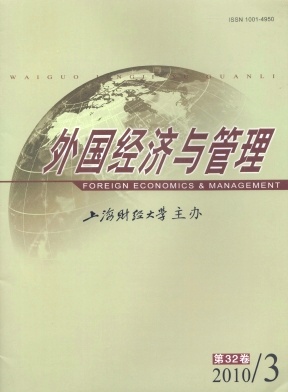竞争优势及其演化研究现状评介与未来展望
外国经济与管理 2010 年 第 32 卷第 03 期, 页码:1 - 10
摘要
参考文献
摘要
竞争优势是战略管理研究的一个核心概念,其重要性不言而喻。然而,现有研究对竞争优势的阐释并不一致,造成了概念使用上的随意性。本文通过对大量相关文献的梳理和评介,提出了一个有助于完整理解竞争优势内涵的概念框架;然后从业绩、价值和能力三个视角对近几年兴起的竞争优势演化研究进行了系统的述评,并认为整合多理论视角是竞争优势研究的必然趋势;最后对竞争优势的未来研究进行了展望。
[1]Teece,DJ,Pisano,G,and Shuen,A.Dynamic capabilities and strategic management[J].Strategic Management Journal,1997,18(3):509-533.
[2]Rumelt,R P.What’s in the worldis competitive advantage[R].Working Paper,The Anderson School at UCLA,2003.
[3]D’Aveni,R A.Hypercompetition[M].New York:The Free Press,1994.
[4]Winter,S.Four Rs of profitability:Rents,resources,routines and replication[A].in Cynthia A Montgomery(Ed.).Resource-based and evolutionary theories of the firm:Towards a synthesis[C].Boston:Kluwer Academic Publishers,1995:168.
[5]Powell,T C.Competitive advantage:Logical and philosophical considerations[J].Strategic Management Journal,2001,22(9):875-888.
[6]Peteraf,M,and Barney,J.Unraveling the resource-based tangle[J].Managerial and Decision Economics,2003,24(1):309-323.
[7]Stoelhorst,J W,and Bridoux,F.Beyond competitive advantage:What cantheories of strategy explain[R].Working Paper,Goizue-ta Business School of Emory University,2007.
[8]Carpenter,M A,and Sanders,WG.Strategic management:Adynamic perspective:Concepts and cases[M].NewJersey:PrenticeHall Press,2007.
[9]马浩.竞争优势的解剖与集合[M].北京:中信出版社,2004:4.
[10]Day,G S,and Wensley,R.Assessing advantage:Aframework for diagnosing competitive superiority[J].Journal of Marketing,1988,52(2):1-20.
[11]周晓东,项保华.什么是企业竞争优势?[J].科学学与科学技术管理,2003,(6):104-107.
[12]Porter,ME.Towards a dynamic theory of strategy[J].Strategic Management Journal,1991,12(S.I.):95-117.
[13]Ketchen,DJ,Hult,T M,and Slater,S F.Toward greater understanding of market orientation and the resource-based view[J].Strategic Management Journal,2007,28(9):961-964.
[14]Barnett,WP,Greve,H R,and Park,D Y.An evolutionary model of organizational performance[J].Strategic Management Journal,1994,15(S.I.):11-28.
[15]Christensen,C M.The innovator’s dilemma[M].Boston:Harvard Business School Press,1997.
[16]Ki m,WC,and Mauborgne,R.Value innovation:The strategic logic of high growth[J].Harvard Business Review,1997,75(1/2):103-112.
[17]Eisenhardt,K M,and Martin,J A.Dynamic capabilities:What are they[J].Strategic Management Journal,2000,21(9/10):1 105-1 121.
[18]Helfat,C E,and Raubitschek,R S.Product sequencing:Co-evolution of knowledge,capabilities and products[J].Strategic ManagementJournal,2000,21(9/10):961-979.
[19]Bingham,C B,and Eisenhardt,K M.Position,leverage and opportunity:Atypology of strategic logics linking resources with com-petitive advantage[J].Managerial and Decision Economics,2008,29(1):241-256.
[20]McGahan,A M.Howindustries evolve:Principles for achieving and sustaining superior performance[M].Boston:Harvard Busi-ness School Publishing Corporation,2004.
①例如,Peteraf和Barney(2003)认为创造更多经济价值的企业享有竞争优势,而Porter(1985)则认为顾客价值大者享有竞争优势。前者的这种经济价值观往往最终向能力观靠拢,例如Peteraf和Barney(2003)进一步指出:“竞争优势可用创造相对多的经济价值的能力来表述。”
②本文不对资源与能力进行特别的区分,参见Bingham和Eisenhardt(2008)。
③但在比较基准或对象上存在争议。Peteraf和Barney(2003)认为应与产业中效率最低的竞争对手比,Porter(1991)认为应该与世界上最强的竞争对手比,而还有很多学者则认为应该与行业平均水平比较(Besanko等,2000)。
[2]Rumelt,R P.What’s in the worldis competitive advantage[R].Working Paper,The Anderson School at UCLA,2003.
[3]D’Aveni,R A.Hypercompetition[M].New York:The Free Press,1994.
[4]Winter,S.Four Rs of profitability:Rents,resources,routines and replication[A].in Cynthia A Montgomery(Ed.).Resource-based and evolutionary theories of the firm:Towards a synthesis[C].Boston:Kluwer Academic Publishers,1995:168.
[5]Powell,T C.Competitive advantage:Logical and philosophical considerations[J].Strategic Management Journal,2001,22(9):875-888.
[6]Peteraf,M,and Barney,J.Unraveling the resource-based tangle[J].Managerial and Decision Economics,2003,24(1):309-323.
[7]Stoelhorst,J W,and Bridoux,F.Beyond competitive advantage:What cantheories of strategy explain[R].Working Paper,Goizue-ta Business School of Emory University,2007.
[8]Carpenter,M A,and Sanders,WG.Strategic management:Adynamic perspective:Concepts and cases[M].NewJersey:PrenticeHall Press,2007.
[9]马浩.竞争优势的解剖与集合[M].北京:中信出版社,2004:4.
[10]Day,G S,and Wensley,R.Assessing advantage:Aframework for diagnosing competitive superiority[J].Journal of Marketing,1988,52(2):1-20.
[11]周晓东,项保华.什么是企业竞争优势?[J].科学学与科学技术管理,2003,(6):104-107.
[12]Porter,ME.Towards a dynamic theory of strategy[J].Strategic Management Journal,1991,12(S.I.):95-117.
[13]Ketchen,DJ,Hult,T M,and Slater,S F.Toward greater understanding of market orientation and the resource-based view[J].Strategic Management Journal,2007,28(9):961-964.
[14]Barnett,WP,Greve,H R,and Park,D Y.An evolutionary model of organizational performance[J].Strategic Management Journal,1994,15(S.I.):11-28.
[15]Christensen,C M.The innovator’s dilemma[M].Boston:Harvard Business School Press,1997.
[16]Ki m,WC,and Mauborgne,R.Value innovation:The strategic logic of high growth[J].Harvard Business Review,1997,75(1/2):103-112.
[17]Eisenhardt,K M,and Martin,J A.Dynamic capabilities:What are they[J].Strategic Management Journal,2000,21(9/10):1 105-1 121.
[18]Helfat,C E,and Raubitschek,R S.Product sequencing:Co-evolution of knowledge,capabilities and products[J].Strategic ManagementJournal,2000,21(9/10):961-979.
[19]Bingham,C B,and Eisenhardt,K M.Position,leverage and opportunity:Atypology of strategic logics linking resources with com-petitive advantage[J].Managerial and Decision Economics,2008,29(1):241-256.
[20]McGahan,A M.Howindustries evolve:Principles for achieving and sustaining superior performance[M].Boston:Harvard Busi-ness School Publishing Corporation,2004.
①例如,Peteraf和Barney(2003)认为创造更多经济价值的企业享有竞争优势,而Porter(1985)则认为顾客价值大者享有竞争优势。前者的这种经济价值观往往最终向能力观靠拢,例如Peteraf和Barney(2003)进一步指出:“竞争优势可用创造相对多的经济价值的能力来表述。”
②本文不对资源与能力进行特别的区分,参见Bingham和Eisenhardt(2008)。
③但在比较基准或对象上存在争议。Peteraf和Barney(2003)认为应与产业中效率最低的竞争对手比,Porter(1991)认为应该与世界上最强的竞争对手比,而还有很多学者则认为应该与行业平均水平比较(Besanko等,2000)。
引用本文
张敬伟, 王迎军. 竞争优势及其演化研究现状评介与未来展望[J]. 外国经济与管理, 2010, 32(3): 1–10.
导出参考文献,格式为:
下一篇:战略共识理论研究述评





 7448
7448  388
388

